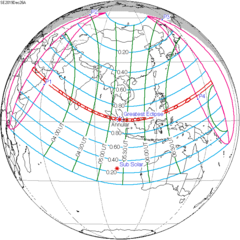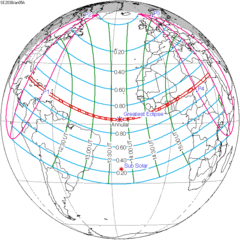|
December 2028 lunar eclipse
A total lunar eclipse will occur at the Moon’s descending node of orbit on Sunday, December 31, 2028,[1] with an umbral magnitude of 1.2479. A lunar eclipse occurs when the Moon moves into the Earth's shadow, causing the Moon to be darkened. A total lunar eclipse occurs when the Moon's near side entirely passes into the Earth's umbral shadow. Unlike a solar eclipse, which can only be viewed from a relatively small area of the world, a lunar eclipse may be viewed from anywhere on the night side of Earth. A total lunar eclipse can last up to nearly two hours, while a total solar eclipse lasts only a few minutes at any given place, because the Moon's shadow is smaller. Occurring about 4.3 days before perigee (on January 4, 2029, at 23:15 UTC), the Moon's apparent diameter will be larger.[2] This eclipse will occur during a blue moon and is the first such eclipse to happen on New Year's Eve and New Year's Day since December 2009, and the first total lunar eclipse on New Year's Day in history. The next such eclipse will be in December 2047 (though January 2048 for most timezones). VisibilityThe eclipse will be completely visible over eastern Europe, Asia, and Australia, seen rising over Africa and Europe and setting over the eastern Pacific Ocean and western North America.[3]
Eclipse detailsShown below is a table displaying details about this particular solar eclipse. It describes various parameters pertaining to this eclipse.[4]
Eclipse seasonThis eclipse is part of an eclipse season, a period, roughly every six months, when eclipses occur. Only two (or occasionally three) eclipse seasons occur each year, and each season lasts about 35 days and repeats just short of six months (173 days) later; thus two full eclipse seasons always occur each year. Either two or three eclipses happen each eclipse season. In the sequence below, each eclipse is separated by a fortnight.
Related eclipsesEclipses in 2028
Metonic
Tzolkinex
Half-Saros
Tritos
Lunar Saros 125
Inex
Triad
Lunar eclipses of 2027–2031This eclipse is a member of a semester series. An eclipse in a semester series of lunar eclipses repeats approximately every 177 days and 4 hours (a semester) at alternating nodes of the Moon's orbit.[5] The penumbral lunar eclipses on February 20, 2027 and August 17, 2027 occur in the previous lunar year eclipse set, and the penumbral lunar eclipses on May 7, 2031 and October 30, 2031 occur in the next lunar year eclipse set.
Saros 125This eclipse is a part of Saros series 125, repeating every 18 years, 11 days, and containing 72 events. The series started with a penumbral lunar eclipse on July 17, 1163. It contains partial eclipses from January 17, 1470 through June 6, 1686; total eclipses from June 17, 1704 through March 19, 2155; and a second set of partial eclipses from March 29, 2173 through June 25, 2317. The series ends at member 72 as a penumbral eclipse on September 9, 2443. The longest duration of totality was produced by member 37 at 100 minutes, 23 seconds on August 22, 1812. All eclipses in this series occur at the Moon’s descending node of orbit.[6]
Eclipses are tabulated in three columns; every third eclipse in the same column is one exeligmos apart, so they all cast shadows over approximately the same parts of the Earth.
Half-Saros cycleA lunar eclipse will be preceded and followed by solar eclipses by 9 years and 5.5 days (a half saros).[8] This lunar eclipse is related to two annular solar eclipses of Solar Saros 132.
See alsoNotes
External links
|
|||||||||||||||||||||||||||||||||||||||||||||||||||||||||||||||||||||||||||||||||||||||||||||||||||||||||||||||||||||||||||||||||||||||||||||||||||||||||||||||||||||||||||||||||||||||||||||||||||||||||||||||||||||||||||||||||||||||||||||||||||||||||||||||||||||||||||||||||||||||||||||||||||||||||||||











































